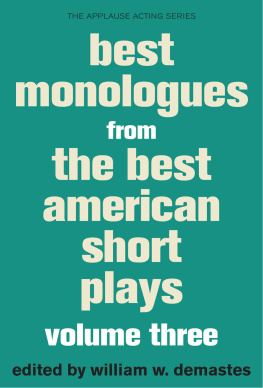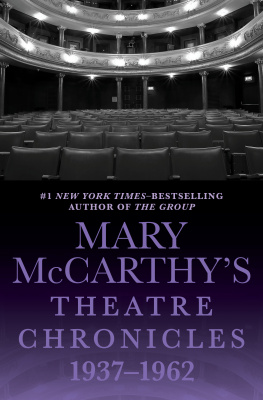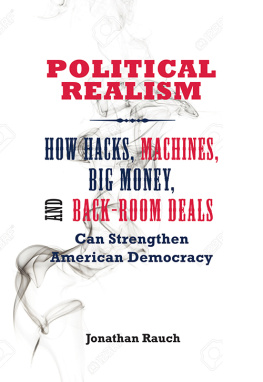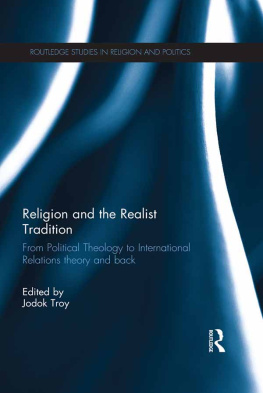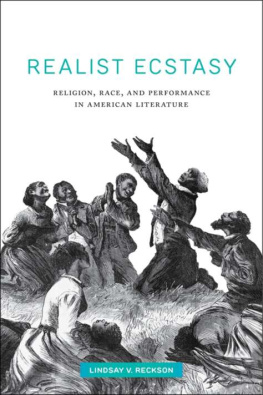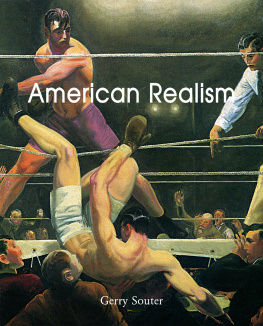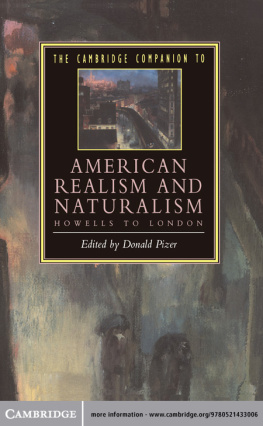Realism and the American dramatic tradition / edited by William W. Demastes.
p. cm.
Includes bibliographical references and index.
ISBN 0817308377 (pbk. : alk. paper)
1. American drama20th centuryHistory and criticism. 2. Realism in literature. I. Demastes, William W.
PS338.R42R43 1996
812.50912dc20
Preface:
American Dramatic Realisms, Viable Frames of Thought
William W. Demastes
The tyranny of realism. This phrase summarizes the impression expressed in numerous critical analyses of twentieth-century American drama. It is true that since the beginning of the twentieth century, realism has been the dominant mode of theatrical expression. While it is also true that America has produced the occasional nonrealist successThe Adding Machine, Our Town, Camino Real, and Angels in Americaeven such playwrights as Eugene ONeill and Sam Shepard, who resisted the call to realism and experimented with other forms, returned to this form if for no other reason than that American audiences have been more willing to accept realist drama than any other form. Their careers demonstrate a cultural feedback loop wherein dramatists write realist plays for American audiences, and audiences in turn come to expect realism of authors. Why American audiences hunger for realism when other national theatres have opened themselves to other forms is a difficult question, but perhaps dispelling several myths about the form will suggest why Americans prefer this much-criticized but nevertheless popular form.
The charge that realism is a tyrant stems from the conclusion that realism is a structurally unambitious, homogeneous, tunnel-visioned form, its every product churning out the same fundamental message and denying creation of a more open, pluralistic theatre. From all that has been written about realism in the theatre, and based on the widespread use of the term, one would assume the term itself had been sufficiently identified, its conditions and parameters established, and its opposites marked. But the fact of the matter is, this term has achameleon-like existence, changing colors at almost every turn and blending into a context appropriate to whatever needs a particular practitioner or critic deems appropriate for his or her goals. Opponents often reduce the term to signifying use of real refrigerators, food, or other props on stage. Others identify it by observing common, unadorned language, and common themes. Similarly guilty of oversimplification, proponents often argue that realism is predicated on objectivity, a faithful rendering of existence without biased impositions on the part of its creators.
It seems we will likely never have a fully delineated and universally satisfactory definition of realismat least, we will never have a single satisfactory definition. If any critic or lexicographer sat down to create a prescriptive definition, much of theatrical and literary history would simply have to be rewritten, for it is unlikely that any prescribed definition would be sufficient to embrace the many past and current applications of the term. In turn, a descriptive definition would need to be so inclusive that the term definition itself would need redefining.
What this book attempts to demonstrate is that realism is a term identifying a rich and varied confederacy of theatrical products bound only by a limited set of prescriptions and utilized by a heterogeneous group of artists. In many cases realism is not so much the tyrant as is the limited critical apparatus of reviewers and audiences who quickly identify superficial qualities in a play and instantly identify the work as being of a type that is intellectually unambitious, aesthetically primitive, and culturally irrelevant. To be sure, this confederacy of realist artists has occasionally created mediocre fare, but so has it created powerful, moving, and stimulating art. One simply cannot condemn the whole lot, as one cannot offer unqualified applause to realist drama as a genre. Each brand of realism, created by each practitioner, has corresponding strengths and weaknesses that should be addressed at different levels and from different perspectives. What one must constantly recall is that instant fallacy occurs when one tries to defend or attack realism without first identifying the particular permutation under scrutiny.
Among these various realisms, there are of course various points of convergence. Minimalization of theatricality is very much a central gauge of realism, upon which rests a fundamental criterion of the realist mode. Theatricality is craft, and craft needs a crafter to manipulatematerial. A realist product minimizes theatricality because theatricality implies a fabrication by a crafter/playwright that belies realisms very essenceobjective intentions. There appears to be no playwright present because forces of nature are designed to replace the playwright as the controller of events. So goes the argument, at least.
Of course, a crafter is very much alive and present in realist drama despite the illusion of absence. In many ways, in fact, creating an untheatrical theatre is the height of theatrical illusion. The realist playwright does control events and does manipulate action (or inaction), as does a creator of any theatrical piece. More frequently than one might expect, fundamentally realist plays even break with realist practice and slip into moments of overt theatrical manipulation. Death of a Salesman and The Glass Menagerie come quickly to mind. Too much overt theatricality, however, ultimately results in the play being labeled something other than realist. The point is that realism is not an either/or proposition. Rather, there is a sliding scale in effect, and depending on critical leanings, an audience may accept certain levels of theatricality but still identify the work as fundamentally realistic. So while realism can be said to be a form that minimizes theatricality, theatricality does have its place to a certain, and always debatable, degree in the realist product. But the restraints under which this realist crafter/playwright operates are more clearlyeven if only genericallyarticulated: the realist playwright is restrained by nature, is essentially required to operate according to rules of reality, whatever they may be at any given moment. What for one generation may be realistic could be for another the height of artifice.
To break with the rules of reality is to create something other than realism. When melodrama transforms a villain into a reformed penitent without sufficient preparation, it has broken accepted rules of psychological credibility. When a letter magically arrives exactly when the plot requires itto save the farm at the last momenttemporal credibility is shattered for most of us. We usually deride poetry from the mouths of dock workers. When sudden confessions of love resolve apparently irreconcilable conflicts, we usually call it romantic comedy and write it off as unrealistic. And when an innocent suddenly dies, we want a reason. In fact, for all of the above, we need reasons, which must themselves satisfy our rules of reality. For someof us, our rules of reality might allow us to accept the above events; for others such events are disallowed.


